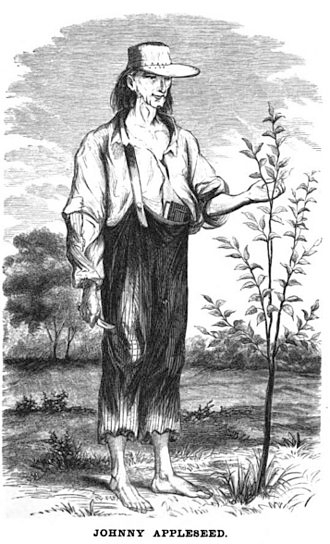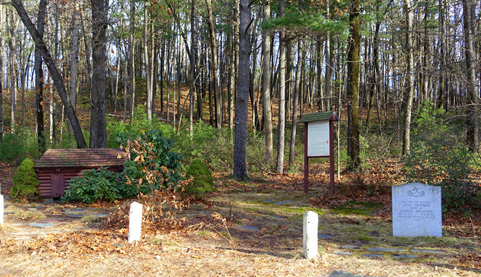
Home >> Newsletters > GreenFriends Newsletters > Q2 2024 Newsletter
| Home | Source Reduction | Friends of Green Friends | Newsletters |
| Gardening | Resources | What You Can Do | Embracing The Trees |
| Johnny Appleseed – An Awesome Tree-Planter |
 |
|
Johnny Appleseed was not just a mythic figure, he was a real person who planted apple trees throughout his entire adult life. It’s estimated he raised about 300,000 apple seedlings in his nurseries in Pennsylvania, Ohio, West Virginia, Indiana and Illinois, and as far north as Ontario, Canada. His real name was John Chapman. He was born on September 26th, 1774, in Leominster, Massachusetts. In his 20s, Johnny was deeply affected by the writing of a Swedish mystic named Emanuel Swedenborg. Swedenborg taught that humans are spirits in material bodies, and that one should do good, and spread the word of God’s goodness and bounty. Swedenborg argued against the prevailing thought at the time, that faith alone could bring salvation. He said faith must be acted upon by doing acts of charity, to earn God’s favor. He said, "the purpose of faith is to lead a person to live according to the truths of faith, which is charity." As well as Johnny Appleseed, Swedenborg’s writings influenced many well-known writers and thinkers, including Carl Jung, William Blake, Ralph Waldo Emerson, Helen Keller, D.T. Suzuki, W.B. Yeats and Honore de Balzac. Johnny reportedly carried Swedenborg’s books and a Bible with him all his days, lived a very simple, frugal life even when he could afford luxury, and was known for his acts of kindness and generosity. At 21, Johnny went westward, first to New York and Pennsylvania, and then on to Ohio. He was described as 5 feet, 7 inches tall, with large bones, strong and muscular from working, but thin from all his walking. Johnny didn’t sprinkle apple seeds randomly. He planted apple nurseries, fenced them to protect them from animals, left them in the care of a neighbor, and returned every couple of years to check on them. He sold young trees for about six and a half cents to settlers moving west. Many land-grant companies required settlers to plant 50 apple trees on their new land within one year. When some didn’t have the cash, he would also accept used clothing, a meal, a place to sleep, food for his travels, or a promise to pay in the future. |
 Johnny Appleseed's Birthplace, Leominster, Massachusetts |
| Top In the fall, he would walk east to the cider mills to stock up on apple seeds and then carry them back west in burlap sacks by horse, raft, and canoe. He often slept outdoors and loved the wilderness. By 1815, he owned 640 acres of land, and had sold thousands of trees to settlers who were migrating west. Although he was not a poor man, Johnny wore castoff clothes and a shirt made of a coffee sack. He was said to wear a tin mush pot for a hat, and to go shoeless even in snowstorms. He preached about Swedenborg’s Church of the New Jerusalem. "His was a strange eloquence at times, and he was undoubtedly a man of genius," said a lady who knew him in his later years. He became a vegetarian, was kind to animals, and it was said he would put out his campfire rather than let mosquitoes be harmed by flying into it. He was friendly with both settlers and Native Americans, had learned enough of some Native American languages to be able to communicate, and sometimes was able to help settle differences between the two groups. Native Americans said he had been touched by the Great Spirit. It was said he helped to heal a wolf’s injured leg, and from then on, the wolf followed him and protected him. When he saw a sick horse that was going to be put down, he bought the horse as well as some nearby grassy land, where it was able to recover. When it was better, he gave the horse to someone needy, asking that they treat it well. |
 Gala apples |
| Johnny was knowledgeable about medicinal uses of herbs, and also planted herb seeds wherever he went. He didn’t believe in grafting apples, so all the apple trees he planted were grown from seed. Apple seeds are heterozygous, so they don’t necessarily grow ‘true to type’ – each seed can grow into a tree with fruit very different from the parent tree.
In his book, The Botany of Desire, Michael Pollan said the apples Johnny Appleseed planted were likely small and bitter, and were most likely used to make hard cider. ”In rural areas, cider took the place of not only wine and beer but of coffee and tea, juice, and even water," Pollan wrote. They may also have been used in jams, jellies or baking, and to feed livestock. Pollan also credits Johnny’s widespread planting of apple trees grown from seed with the development of new varieties such as Delicious and Golden Delicious apple trees. Grafting ensures that the apples will be the same variety as the grafted variety, whereas, when trees are instead grown from seed, each seed could grow into a tree with apples that taste different than those on the original tree. Many of the trees may bear fruit that is bitter. But by planting many seeds, conditions were created for new varieties, some of which were very tasty. More info: https://web.archive.org/web/20060905033519/http://www.in.gov/ism/Education/Johnny_Appleseed.pdf https://en.wikipedia.org/wiki/Emanuel_Swedenborg Tirtha G. - Vancouver Island, BC |
Read Nature & Amma in the Q2 2024 Newsletter >>
| Home | Source Reduction | Friends of Green Friends | Newsletters | Resources | What You Can Do | Embracing The Trees |
For more information, e-mail info@greenfriendsna.org |
||||||